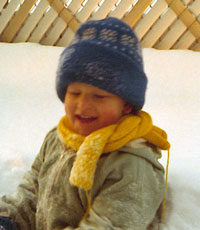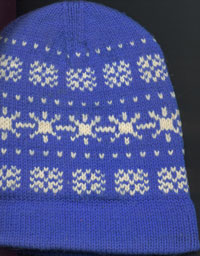
The story of this hat began in the fall of 1979. I was working for J. Calvin Giddings in the Chemistry Department at the University of Utah in Salt Lake City. Karin D. Caldwell, part of our research group and a proud citizen of Sweden, had worn several beautiful traditional hand knit sweaters to work. This was the first I had seen up close the results of techniques that I had read about in Elizabeth Zimmerman's Knitting Without Tears. One day Karin brought in a "ski" hat with patterns in white and dark grey in a fine wool similar to, but not quite like Meg Swanson's Swedish Dubbelmössa hat kit.
It was basically a cylinder with both ends closed. The "inside" end was tucked into the crown, then the edge was turned up to make a cuff of four layers of knitting over the ears.

I had some knitting worsted in medium blue and some white which would look good on a blond, blue eyed boy who was almost two. After capturing the toddler and measuring his head, I cast on 99 stitches in the blue on a circular needle, joined it, and knit around plain for 4.5 inches. I then started the patterns, which had a 9 stitch repeat, carrying the white on one hand and the blue on the other taking care to leave the loops fairly loose for 6 more inches. I then divided the stitches into four sections with markers and decreased on either side of each marker every other row until the work became tight, then transferred onto sock needles until there were two stitches left on each section. I then threaded the end through the loops and broke the yarn. I think this was the "second" fitting, and found there was some room to grow.
The blue yarn was almost done, but I darned in the ends and picked up and knit the cast on stitches until it was used up, almost another inch. I had some gold worsted weight yarn and some charcoal gray sport weight yarn, so switched to the gold and knit about an inch, then knit the child's name and date over 5 rows in the charcoal filling in the extra spaces with diagonal lines 3 stitches apart. I continued knitting and got well up onto the crown when the gold started to run out. This hat takes about the same amount of yarn as three plain hats! I joined in the charcoal and knit a simple pattern for a transition, then switched to all gray. I took care of the ends, then knit plain for about an inch then divided into four sections and decreased to close the end.
So, what I had was an prolate spheroid, a shape formed when an elipse is rotated around it's major axis, 21 inches long. The circular cross section at it's center was 20 inches diameter. The child, totally oblivious to the geometry, wore it to play in the snow and everyone thought it was cute.
I made several adult versions in Icelandic yarn and another for the child in rainbow stripes that never came back after a day care trip to see a performance of Peter Pan where the child decided to try being one of the lost boys. Several years later I made a red hat for the child to match a favorite sweater, which he wore for years. I ended up knitting the inside sections in lighter weight yarn. When I began spinning, I found that brushing the Icelandic wool with my cards to raise the nap made an even warmer hat.
This is still one of my favorite hat patterns, either in one color or patterns. I now use fingering or sport weight wool and have been starting on the inside and increasing instead of knitting the outside first then picking up stitches for the lining. It doesn't have a wrong side and the tension produced by turning up the cuff makes it stay on even without any ribbing. Washing it is a lot easier than for other heavy hats because when it is unfolded, there are only two layers.
The biggest challenge is to keep on knitting even with it seems to be impossibly long. Folklore has it that you should be able to carry a sandwich in the space at the top to snack on while cross country skiing.